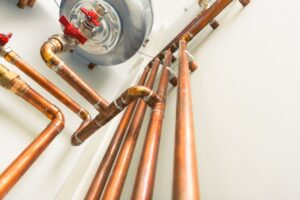The term hydronic heating is a broad one that covers several types of heating systems used in commercial, industrial, and residential buildings and facilities. It’s sometimes conflated with radiant heating, but radiant heating refers to a way heat moves through a space, while hydronic heating is the method used to produce the heat.
This might sound a bit confusing, but below we’ll go into what makes hydronic heating different from other heating types you may have installed for your commercial heating in Toronto, ON.
Radiant Heating
First, we need to discuss the meaning of radiant heating. Radiant heating is one of three ways that heat can move. The other two are convection and conduction. Convection is heat moving through air, which is the way that forced-air heating systems like furnaces and rooftop HVAC units deliver heat.
Conduction is heat transferred through contact, such as when you touch a hot surface. Radiant heating is the movement of heat from a heated surface to another surface without heating the air between. The most basic form of radiant heating is the heat coming from the sun. You experience radiant heat when you stand near a hot surface and feel the warmth, well, radiating from it.
Radiant heating systems operate by raising the temperature of an object so that it warms other objects nearby. Radiant heating systems can warm up radiators, baseboard heaters, the floor, or the walls. The way it creates that heat is what brings us to hydronic heating.
Hydronic Heating
This is heating created by raising the temperature of water. It’s the most effective and energy efficient way to provide radiant heating. Some radiant heating systems use electricity to raise the temperature of objects (such as wall heaters), but this consumes much more power than hydronic heating. Water is one of the most effective thermal transfer mediums, making it ideal for warming large areas with radiant heat.
Hydronic Heating Systems
The majority of hydronic heating systems use gas-fired boilers to raise the temperature of water, which then passes through a manifold and out to various terminal points such as radiators and in-floor heating elements. Boilers can use hot water or steam. (All boilers once used steam, which was why they were called boilers in the first place.) Steam boilers have greater heating power, but are mostly relegated to industrial and larger commercial use. Hot water boilers have overtaken steam boilers as the baseline for hydronic heating.
Hydronic Heating Benefits
For many commercial and industrial facilities, hydronic heating is a superior option to forced-air heating, particularly for facilities that need to reduce the number of particulates in the air. Because hydronic heating doesn’t use blowers or fans, it doesn’t stir up dust and other particles and helps to create cleaner air inside a facility. Hydronic systems also create less noise than forced-air systems, are extremely energy efficient, and have longer service lives.
If you’re looking for hydronic heating systems for your facility or require service for currently existing ones, our experienced team is the one to call.
Advantage Airtech Commercial Ltd. is the Double “A” Name with the Triple “A” Rating. Contact us today to arrange for heating services for your commercial or industrial facility in the Greater Toronto Area.


